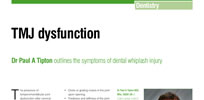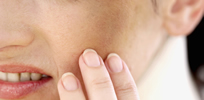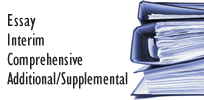Abfraction Cavities:- grooves formed in the necks of teeth as a result of a combination of heavy tooth brushing, erosion, attrition and gum recession.
Abscess:- a swollen area within body tissues containing an accumulation of pus.
Abutment/Retainer Tooth:- a tooth which is prepared to support a bridge.
Acrylic:- plastic.
Adult Periodontal Disease:- inflammation of the gingivae caused by the bacteria in our mouths. A common condition which can be treated by regular professional tooth cleaning and fastidious oral hygiene habits, eg. flossing and toothbrushing.
Amalgam Filling:- an alloy of mercury and silver plus other metals to give a set material. It does not adhere to tooth tissue and is not tooth coloured.
Amitriptyline:- this drug is an anti-depressant which can also be used as an analgesic. In conditions such as a typical facial pain they may be used as the sole analgesic. In hospital Amitriptyline is a commonly used anti-depressant and is a sedative tricyclic anti-depressant. There is often an interval of two to four weeks before this type of drug reaches a level which exhibits a clinically evident anti-depressant effect.
Anaesthesia:- the absence of pain.
Anaesthetic:- a local anaesthetic, usually lignocaine and adrenaline.
Analgesia:- is the absence of pain.
Angle’s Classification III Malocclusion:- describes the situation where the lower incisor edges lie anterior to the upper incisors.
Anterior External Auditory Meatus:- the front wall of the ear hole which over lies the posterior aspect of the temporomandibular jaw joint area.
Apical:- root tip (apex) of a tooth.
Apical Inflammation:- inflammation at the root tip (apex) of a tooth.
Apicectomy:- This is a second line treatment after the failure of, or as a supplement to, a root filling. It may be performed because of persistent infection due to periapical abscess. It is often performed under local anaesthetic. A flap of gum is folded back above the tooth to be treated. A window is cut in the bone over the tooth root, the tip of the tooth is cut off and effected material cleaned out from around the root tip. The root tip is then often filled with an amalgam filling. The surgical wound is closed and stitched. An alternative is to perform a pull through procedure where the canal is prepared for a root filling at the same time as an apicectomy. Often there is post operative swelling.
Articulator Disc:- a disc of fibrocartilage which is usually between the head of the condyle (of the temporomandibular joint) and the glenoid fossa (base of the temporal bone of the head).
Aspirin, Dycodomol and Morphine:- these are examples of pain killers.
Asthma:- is a reversible constriction of the bronchi of the lungs which causes wheezing and difficulty breathing.
Atypical Facial Pain:- a painful syndrome characterised by dull aching or throbbing pain. Attacks last from a few days to several months and seem to occur after dental work, but examination tends to seldom reveal any abnormalities. A psychogenic etiology has been suggested.
Attrition:- the physical wear caused by the movement of the tooth against another and is increased in bruxism.
Avulsed:- describes the complete removal of a tooth (crown and roots) as the result of trauma.
Bite Wings:- a type of radiograph scan which is very accurate when screening for, eg. tooth decay, defective restorations.
Bleaching:- employment of a chemical agent to lighten the shade of a tooth.
Bone graft:- if insufficient bone is present can be grafted into a site via further surgery.
Bone scan:- a scan which demonstrates how much bone is present in a site.
Brace:- orthodontic appliance used to straighten teeth. This may be fixed or removable.
Bridge:- is not removable by the patient. It is held in place by cementation to prepared teeth.
Bridgework:- a fixed partial denture that is cemented or otherwise securely retained to natural teeth or tooth roots.
Bruxist/Bruxism:- describes an abnormal habit whereby a person grinds their teeth. This may occur unconsciously whilst asleep. A type of parafunction and may place abnormally high occlusal loads on teeth. It may be stress induced, causing pain in the teeth, jaw and associated jaw muscles.
Calcification:- the pulp chamber inside a tooth can close up in reaction to trauma.
Calculus:- hard deposits which form on teeth and cannot be removed by toothbrushing.
Cantilever Bridge:- a bridge which is constructed on a single retaining natural tooth.
Carbamazepine :- primarily an anti-epileptic drug which is of considerable value of the management of trigeminal and glossopharyngeal neuralgia. This drug requires careful supervision by a medical practitioner as blood dyscrasias may occur within the first three months. It is important to be sure of the diagnosis before starting patients on long term Carbamazepine.
Cast Restorations:- Metal or porcelain bonded to metal restorations placed onto the tooth in the form of onlays or crowns.
Cervical:- neck.
Chronic Adult Periodontitis (gum disease):- a disease of the gums caused by the body’s reaction to the bacteria around the teeth. The disease results in the loss of bone from around the teeth and inflammation of the gum.
CPITN:- the Community Periodontal Index of Treatment Need. This indicates the need for periodontal (gum) treatment.
Class I occlusion:- a normal arrangement of teeth, which may or may not be crowded
Class II, Division I Malocclusion:- describes the situation where the upper teeth protrude forwards.
Clearance:- to have all the remaining natural teeth extracted.
Click:- a brief sharp sound occurring within the temporomandibular joint.
Complete Dentures:- plastic false teeth attached to a plastic base which replaces all the natural teeth.
Composite White Filling :- a mixture of resin and particles to give a set material. It does adhere to tooth surfaces and is tooth coloured.
Congenitally/Congenital:- a disease or physical abnormality present from birth.
Contraindication:- a condition or circumstance which suggests or indicates that a particular technique or drug should not be used in the case in question.
Cranial Nerve:- a group of twelve pairs of nerves which are concerned with the head and neck.
Crepitus/Crepitation:- is a grating sound described as rather like walking on gravel and has been shown to be commonly associated with osteoarthritis.
Crown:- replaces the missing or broken tooth tissues of the top of a tooth. The tooth is prepared, impressions taken and a constructed crown cemented in place.
Cyst:- a collection of an abnormal substance.
Deciduous Tooth:- first or baby tooth.
Dental Abscess:- a collection of pus at the tip of a tooth.
Dental Caries/Tooth Decay:- is a sugar dependent infectious disease characterised by episodic demineralisation and remineralisation occurring over time. If destruction predominates this will lead to cavitation of the teeth.
Dental Implants:- are titanium screws placed in the jaw which become integrated with bone, giving a stable platform for the placement of a prosthesis (artificial teeth). e.g. a crown, denture or bridge.
Dental Plaque:- the soft bacterial deposits which form on teeth and require removal by tooth brushing each day.
Dental Pulp:- the blood vessels and nerve tissue inside a tooth.
Dentine:- inner layer of a tooth.
Dentures:- plastic false teeth attached to a plastic or metal base which replaces natural teeth.
Diagnostic study casts:- study models mounted in the correct mouth relationship on an articulator.
Diagnostic Study Models:- plastic casts of the teeth which may be mounted on a hinge articulator which stimulates the movements the jaw makes in three dimensions. Used for diagnosis, treatment planning and the construction of crowns, bridges and dentures.
Diagnostic wax up:- a wax mock up of the proposed final result of restorative dentistry.
Draining Sinus:- describes when pus drains to the surface of the gum.
Enamel:- the outer surface of a tooth.
Endodontics:- is the study and practice of root canal treatments.
External Resorption:- The root of a tooth resorbs away.
Extract:- to remove a tooth/teeth.
Extraction:- surgical removal of a tooth.
Face bow transfer:- a simple procedure which enables the study model of the upper teeth to be mounted in the correct relationship to the condylar axis. This procedure assists the diagnosis and treatment planning of advanced dental restorations and enables a laboratory technician to construct a crown and bridgework which fit harmoniously into the patient’s existing ‘bite’.
First Prematurity:- the first teeth to touch together when the mandible (lower jaw) closes around its most natural arc of closure.
Fixed Bridge:- a prosthesis to replace missing teeth and gingivae which is supported by dental implants. It is either screwed or cemented in place.
General Anaesthesia (GA):- is a state of unarousable unconsciousness to which analgesia and muscle relaxation is added to produce ‘balanced anaesthesia’.
Gingivae:- the gums / gum tissue.
Gingivitis:- inflammation of the gingivae (gum) caused by the bacteria in our mouths.
Gold Inlay :- a gold ‘jigsaw piece’ which is cemented into a prepared cavity in a tooth to restore its form and function.
Grade I Mobile:- a tooth which moves side to side by 1mm.
Gum Disease:- inflammation of the gum tissues. Plaque is the principal aetiological factor in virtually all forms of gum disease.
Gum Boil:- a swelling on the gum formed when the infection from a tooth tracks to the surface to drain.
Haemorrage:- bleeding.
Hyperplasia :- defective or incomplete development.
ICP:- the intercuspal position is the position of the teeth when they are maximally interdigitated.
Immediate Dentures:- dentures which are provided immediately after teeth have been extracted. They are provisional and short term solutions which require modification and early replacement.
Implant:- a titanium screw placed in the jaw and becomes integrated with the bone, giving a stable platform for the placement of a prosthesis (artificial teeth).
Implantologist:- a specialist concerned with the provision of dental implants.
Incisal Edge:- the biting edge of a tooth.
Infection:- to be affected by a disease causing organism.
Inferior Dental Nerve Block (IDB, Inferior Alveolar Block):- the technique of choice to anaesthetise mandibular molars, premolars, canines and incisors. Aims to deposit local anaesthetic solution around the inferior alveolar nerve.
Infiltration:- the aim is to deposit a local anaesthetic solution as close as possible to the root tip of the tooth to be anesthetised. The needle is inserted into the gum along the long axis of the tooth aiming towards the bone.
Inflammation:- a localised physical condition in which part of the body becomes reddened and swollen often a reaction to injury or infection.
Infraorbital Nerve:- a branch of the maxillary nerve (an intermediate division of the trigeminal cranial nerve).
Intercuspal Position (ICP):- The position of complete intercuspation of the opposing teeth independent of jaw position.
Internal Bleaching:- a chemical agent can be placed inside a root filled tooth in order to bleach it back to its original colour.
Internal Resorption:- The inside of a tooth resorbs away – and the pulp chamber becomes larger.
Intravenous:- administering a drug into a vein.
Labial:- the surface of a tooth or structure which faces the lip.
Local Anaesthesia:- is the technique of choice for simple procedures or when a general anaesthetic is contraindicated.
Luxation:- the displacement of a tooth due to trauma.
Magnetic Resistance Imagery:- -a non-invasive method for investigating temporomandibular jaw joint disc lesions and displacements.
Mesial Drift:- describes the tendency for teeth to drift forward into spaces where teeth have been removed.
Mobility:- describes the looseness of a tooth.
Morphology:- the three-dimensional shape and form of teeth.
Mounted Study Casts :- Study models mounted in the correct mouth relationship on an articulator.
Nayyar Core:- a type of filling placed on molar root filled teeth to provide a foundation for the placement of a crown.
Needle Phobia:- an irrational fear of injections.
Nerve:- a fibre which conducts nerve impulses.
Non Working side interference:- undesirable contacts of the opposing occlusal surfaces on the non working side.
Occlusal Adjustment:- Planned change in the occlusion (bite) intended to permanently alter the occluding (biting) relationships.
Occlusal Equilibration:- the modification of the shape of the teeth producing even tooth contacts.
Occlusal Splint:- A removable artificial occlusal surface used for diagnosis or therapy affecting the relationship of the mandible to the maxillae. It may be used for occlusal stabilisation, for treatment of temporomandibular disorders, or to prevent the wear of dentition.
Occlusion:- The static relationship between the incising or masticating surfaces of the maxillary or mandibular teeth.
OPG Radiographic Scan:- a radiograph produced by a panoramic machine (orthopantograph) to produce a scan of the entire upper and lower jaws.
Oral/Maxillofacial Surgeon:- a surgeon who has undergone specialist training, concerned with the head and neck.
Oral Mucosa:- the surface lining of the mouth (oral cavity).
Orthodontics:- The study of moving teeth with a brace.
Orthodontist:- a dentist concerned with the straightening of crowded teeth.
Osteoarthritis:- chronic degeneration and destruction of the articulator cartilage and/or fibrous connective tissue linings of the joint components and discs. This may lead to bony spurs, pain, stiffness and limitation of movement. Advanced conditions may involve erosions and disc degeneration with crepitus.
Overdenture:- an overdenture may be held in place by dental implants. It can be removed by the patient for cleaning.
Parafunction:- abnormal occlusal loads placed on teeth because of habits or function of a patient.
Periapical Abscess:- When the nerve in a tooth dies the bacteria and nerve pulp breakdown products leave the tooth via the opening at the tip of its root. This leads to inflammation and pain. The periodontal ligament which supports the root becomes inflamed. The infection may track to the surface of the gum and cause swelling or drain through a sinus in the gum into the mouth. Teeth with periapical abscesses must be either root filled or extracted.
Periapical Lesion:- disease around the root tip of a tooth.
Periapical Radiograph:- a radiograph image employed to produce a very accurate scan of individual teeth and their roots and surrounding bone.
Pericorinitis:- is inflammation and infection of a gum flap (operculum) overlying a partially erupted tooth, usually a wisdom tooth. Nearly all wisdom teeth associated with periocorinitis need removal.
Periodontal disease:- a disease of the gums caused by the body’s reaction to the bacteria around the teeth. The disease results in the loss of bone from around the teeth and inflammation of the gum.
Periodontal Ligament:- the ligament which supports the tooth in the jaw.
Periodontal Pockets:- periodontitis resulting in the loss of bone and attachment of the periodontal ligament to a tooth. This results in spaces down the sides of the teeth called “pockets”.
Periodontitis:- Periodontitis is caused by the colonisation of the gum by bacteria within dental plaque. It may be due to poor oral hygiene or poorly fitting crowns and filings. The gum bleeds when gently probed and there is also bone loss from between the teeth. Initially the disease is not a painful condition.
Pins:- small pins placed into the dentine to help retain fillings.
Plaque:- dental plaque is a mass of bacteria which adheres to the dental tissues. It can be removed by tooth brushing.
Pockets :- periodontitis resulting in the loss of bone and attachment of the periodontal ligament to a tooth. This results in spaces down the sides of the teeth or ‘pockets’.
Porcelain Veneer:- an artificial replacement that restores missing tooth structure and is cemented to the tooth.
Porcelain:- ceramic.
Post:- a cast metal post used to replace missing tooth tissue after a root filling.
Prosthesis:- an artificial replacement of an absent part of the human body.
Specialist Prosthodontist:- a dentist who has successfully completed an advanced education program and specialises in a branch of dentistry pertaining to the restoration and maintenance of oral function, comfort, appearance and health of the patient by the restoration of natural teeth and/or the replacement of missing teeth and associated tissues with artificial substitutes.
Psychiatrist:- a medical practitioner specialising in the diagnosis and treatment of mental illness.
Psychogenic :- having a psychological origin or cause rather than a physical one.
Psychomatic:- pertaining to the mind-body relationship; having bodily symptoms of a psychic, emotional or mental origin.
Pulp Necrosis :- describes the situation when the pulp dies.
Pulp:- blood vessels and nerve tissue inside a tooth.
Pulpitis:- inflammation of the pulp.
Pus :- debris produced by an infected tissue.
Radiolucency:- a diffuse substance appears dark on a radiograph because x-rays pass easily through it, eg. abscess.
Radioopaque:- a dense solid object stops x-rays as appears white on a radiograph, eg. fragment of tooth.
Removable Bridge:- this is smaller than a denture and can be removed by the patient for cleaning. It is held in place by dental implants.
Retainer tooth:- the tooth/teeth which have been prepared to support a bridge.
Retainer:- a splint used after orthodontic treatment to hold teeth in their new position whilst the supporting bone fully natures.
Retruded Contact Position (RCP):- is the position of the mandible where initial tooth contact occurs on the retruded arc of closure.
Root filling:- a filling placed into the root after the nerve has been removed.
Sedation, Conscious Sedation, Intravenous Sedation (IV Sedation):- is an extension of local anaesthetic technique employing sedative drugs, eg. Benzodiazepines. It is of benefit to anxious patients and a kind of supplement to oral surgery, eg. wisdom tooth removal.
Sinus:- the communication which forms when an infection, for example at the root tip of a dead tooth, tracks to the surface of the gum.
Slide:- in approximately 10% of patients RCP and ICP are coincident. In the remainder there is a forward slide from RCP to ICP. A slide is describe by its largest component, either horizontal or vertical.
Sore Tongue:- may occur in the presence or absence of clinical changes. A clinically normal tongue in the absence of any organic cause is often psychogenic in origin.
Specialist Endodontist:- a specialist concerned with root filling teeth.
Specialist Implantologist:- a specialist concerned with implant surgery.
Specialist Orthodontist:- a specialist concerned with developing dentition and disorders.
Specialist Restorative Dentist:- a dentist concerned with the conservation of teeth and restoring dentitions.
Splinting:- involves fixing teeth together in order to stabilise a loosened tooth and encourage healing of the periodontal ligament.
Subluxation:- partial displacement of a tooth.
Temporary bridge:- employed as a temporary measure and to aid treatment planning. Constructed out of plastic with or without a metal framework.
TMJ (Temporomandibular Joint):- the joint between the temporal bone and mandible.
Temporomandibular Joint Dysfunction Syndrome:- abnormal, incomplete, or impaired function of the temporomandibular joint(s).
Tooth decay:- disease resulting in the demineralisation, cavitation and breakdown of calcified dental tissue by microbial activity.
Trigeminal nerve:- provides a nerve supply to many parts of the head.
Unilateral Partial Denture:- a denture which replaces missing teeth but does not bodily extend across the centre line of the dental arch in which it is employed.
Venepuncture:- the puncture of a vein as part of a medical procedure, typically to withdraw a blood sample or for an intravenous injection.
Vitality Testing:- testing the tooth with a cold solution – this tests the integrity of the nerve.
Wear Facets:- the areas of wear on the cusps of teeth indicating a bruxist habit.
White Filling:- a mixture of resin and particles to give a set material. It does adhere to tooth tissues and it is tooth coloured.
Wisdom Teeth:- the third molars. As the last tooth to erupt, the third molar is liable to be prevented from doing so in a crowded mouth. Wisdom teeth may develop symptoms, eg. pain, swelling, pericorinitis and sometimes a foul taste.
Zsigmondy-Palmer:- a type of dental tooth notation to show the exact position of a tooth in the mouth.











